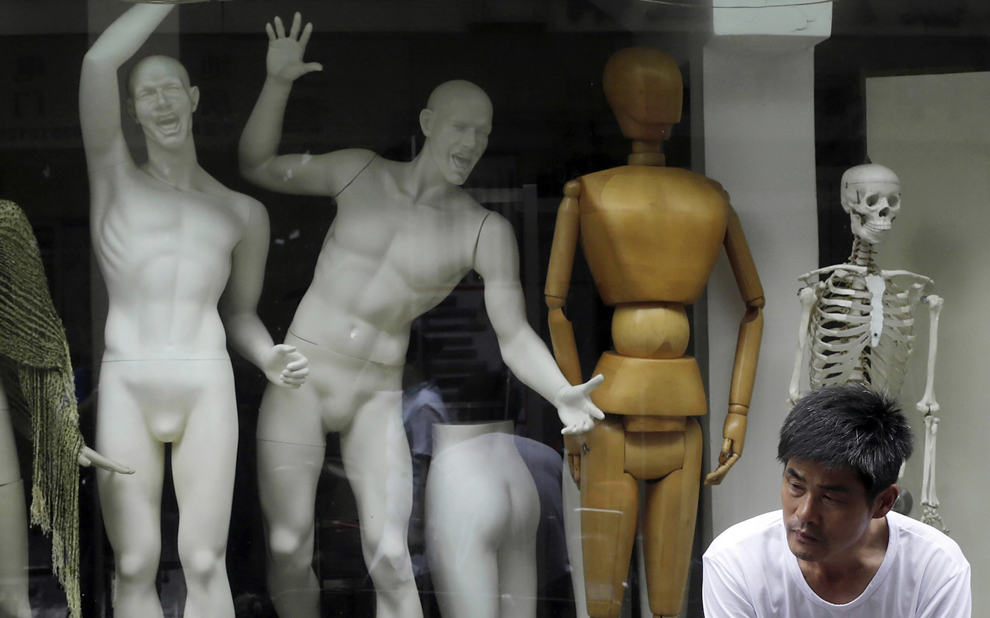Mannequins typically are designed to serve a smooth process of consumption, so it’s a bit odd to see them behaving like madmen.
Of course, it’s a bit odd to see them behaving at all, much less as wildly emoting actors. One can almost see the classical masks of tragedy and comedy, except that each is twisted in the direction of the other to become grotesque. The bodies themselves are more familiar, but something is off there as well: they are both visibly pieced together and organically, athletically posed. Beautifully molded and thoroughly expressive, yet obviously inanimate, and well muscled yet neutered, these human models are disturbingly uncanny.
The rest of the tableau is equally strange. An antique robot and a plastic skeleton set out two variations of the theme of human modeling: the hidden structure of a person and an obvious substitute for the outer form. These two are neutered, but also not gendered (unless you see sexual dimorphism in the pairing), unlike the other two pieces. And I do mean pieces: the female body is present but never whole. As each torso is cut along a different axis, you can’t even put the two parts together. A least one is clothed, so women still get to be decorative–that must be a relief!
There is just enough reflection in the window to indicate that the six actors in search of an author are behind glass. They may look crazy at best, but at least they are interred, set apart, under surveillance, and otherwise locked up and off the street. You can’t even hear the wailing, and so the asylum has done its job. And that about wraps up the story.
Oh, yeah, except for the guy in the corner. He adds another reflective element to the scene. Were this a museum rather than a street in Shanghai, you might wonder if we were another statue. Short of that, he must be human. Like other people, he is both not alone and alone. Positioned between the enclosed copies behind him and the viewer looking into the display case of the photograph, he becomes a representative figure, but of what? Dominated by the alien species towering over him while cut off from anyone else, he seems merely human, not triumphantly so.
Sixty years ago, when The Family of Man exhibition was traveling the world, photography created a particular form of humanism–one that had its problems, but for all that was still egalitarian, pluralistic, and intentionally progressive. By gazing at the ordinary person amidst the common routines of ordinary life, you could see humanity. That vision has been criticized, co-opted, worn out, and displaced, but photographers continue to prompt reflection on what it means to be human. Equally important, they do so in response to the emerging challenges that modern civilization presents to human dignity.
Photography is suited to this work because it is tied up so closely with both technological change and social consciousness. The camera both records and prompts interaction, and does so through processes of mechanical duplication. You might say it makes mannequins of us all. Instead of capturing the human essence, it reveals the deep artifice dominating the human world. But not completely: photography is not the camera alone, and so there we are, like the man in the corner of the image. He’s a real person, an original, and all the more strange and sad for that.
Photograph by Eugene Hoshiko/Associated Press. For review of the debates about The Family of Man exhibition (and book), see Eric J. Sandeen, Picturing an Exhibition: The Family of Man and 1950s America.

Straw mannequin:
http://www.efn.org/~hkrieger/hgo128.jpg